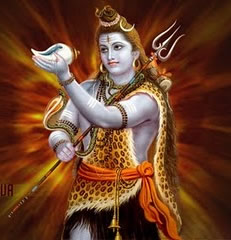SHIVA PURANA |
|
 |
Puja Vidhhanam or the Course of Worship to Bhagavan Siva Bhagavan Siva explained in great detail to Devi Parvathi the process of worship aimed to Him. First construct a ‘Chaturasra Mandala’ or a square form of Worship Place and an Eight-petal Lotus inscribed therein with eight designated deities seated with appropriate hymns in the eight directions. The entire process of Mandala construction and decoration with appropriate colour schemes and placement of deities is quite elaborate and comprehensive. |
Before seated, the devotee should ensure that the required Puja materials are in place, take the blessing of his Guru, resolve that the Puja be a success, recite the Pranava Mantra and seek the permission of Lord Ganesha that there there should not be any hindrance whatsoever during the course of the Puja. The devotee should seek the blessings of Brahmanas, think of the blessings of Great Sages, recite the Soura Mantra invoking Suryadeva, Gayatri and initiate the Puja with the six lettered Bija Mantras like Hram, Hreem, Hruum etc. and after sprinlking water in the Agneya direction where Agni is situated in the respective Lotus part of the diagram, initiate ‘Archana’ (Puja) to Kalagni, Rudra, Adhara Shakti, Anantha Prithvi, Ratnadwip, Sankalpa Vriksha, and Rathna Peeth, Dharma, Gyan, Vairagya and Ishwarya. Thereafter, set up Bhagavan Siva’s idol on a throne. Then, the devotee should break ‘Prana Vayu’ or Life Breath at ‘Muladhara’, with the help of pingala nadi and raise up ‘Adhara Sakti’ to have a glimpse of Bhagavan and Bhagavati and worship with flowers and ‘Manthra Pushpas’ or Hymns of Praise. One should experience the sacred feeling of the appearance with Bhagavan wearing Rudraksha malas, Pasha (noose), Khatvanga (club)), Ankusha (Goad), and Kamala. He possesses four faces and twelve eyes, with Ganga on His matted hairs, Moon on His head, blue throat, ashed body and hissing snakes all around. That is the time when the devotee recites Hram Hreem Sah Om invoking Surya Deva and Bhagavan and Devi later on with appropriate mudras and Anga Nyasas with the continuous recital of Mula Mantra: Hraam Hrem Hruum. After offering the traditional ‘Pancha Upacharas’ or the Five Services viz. Gandha (Sandal Paste), Pushpa (Flowers), Dhoop (Incense), Dipa (Lights), and Naivedya (Offering of Food), there should be Sankalpas (Resolution), performance of three pujas to the Principal Deities and ‘Yagnas’ in favour of ‘Shadangas.(‘Siksha’ or Phonetics, Vyakaranam or Grammar, Jyotisham or Astrology, Chandas or Prosody, Nirutam or Etymology, Kalpam or a mode of Sacrifice) as well as Lotus. In the Second ‘Avarana’, archanas are executed in favour of Agni, Eswara and Vayu as also the Twelve Adityas like Aditya, Bhanu, Ravi, Bhaskar; in the Third Avarana, worship is carried out to ‘Navagrahas’ and Twelve Rasis, viz. Mesha, Vrishabha, Mithuna, Karkataka, Simha, Kanya, Thula, Vrischika, Dhanus, Makara, Kumbha, and Meena. Also, yagnas be perfomed in favour of Oceans, Ganga, Rishis, Gandharvas, Pannagas, Apsaras and so on. The Fourth Avarana is taken up by offering water filled in a copper vessel to Suryadeva along with flowers, sandal paste, ‘akshatas’ or rice grains with turmeric powder, Kumkum and so on. After tendering ‘Arghya’ as above, appropriate Mantras be recited in praise of the Principal Deities of Siva and Parvati as also other Deities of Rudra, Brahma, Vishnu, Ganesha, Skanda, Nandi and others with extreme piety, sincerity and devotion, the devotee might round up the Worship with Pranava Mantras, Shanti Mantras, Astraya Phut etc.as also execute the rest of the ‘Shodasopacharas’ and finally prostrate before the Preceptor for his blessings. At the end of the worship, the offerings to Bhagavan Siva and Devi like the Panchamritas, Fruits, Naivedya or food material are distributed to the devotees present. |
|
| Shiva Purana Home |  |
Next:Description of Bhagavan Siva |
Back to the News Page